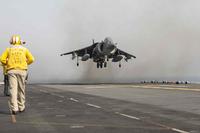 Air Force and Navy engineers might not have solved the riddle after all to what's causing F-22 pilots to suffocate when flying the vaunted fifth generation fighter jet.
Air Force and Navy engineers might not have solved the riddle after all to what's causing F-22 pilots to suffocate when flying the vaunted fifth generation fighter jet.
F-22 pilots stopped wearing pressure vests in June after it was discovered the vests that prevent pilots from blacking out chronically failed and restricted the pilots' breathing. Air Force officials claimed to not have any documented cases of hypoxia since ditching the vests that maintain blood flow during the high-G maneuvers the pilots perform.
The Air Force thought it finally had found the "root cause" that had long escaped the Air Force's investigative team.
That is until the Air Force agreed to escort Elisabeth Bumiller of the New York Times to Joint Base Langley-Eustis, Va., to watch F-22 operations. Bumiller writes in this morning's story that she witnessed a pilot pull the emergency oxygen handle.
"But last week, as Air Force officials escorted a reporter and a photographer to the Langley flight line to watch F-22s roaring on and off the runway for an ostensible good-news story, it happened again. A pilot pulled his emergency oxygen handle sometime after landing because of what the Air Force characterized as “discomfort” from intermittent air flow into the pilot’s mask during flight. The Air Force is investigating but so far has said little."
The oxygen issues have stumped the Air Force for almost two years now. An issue that sort of flew under the radar while Congress and the media were distracted by the problems with the F-35's development, two F-22 pilots brought the oxygen problems out into the national spotlight with their appearance on 60 Minutes.
Air Force leaders have intermittently grounded the F-22 fleet as they have explored the problems and restricted the distance pilots can fly from base and the altitude the fighters reach. Defense Secretary Leon Panetta has instructed the Air Force not to fly F-22s more than a 30-minute flight away from base and pilots must stay under a 44,000 foot ceiling.
This has not kept the Air Force from deploying an F-22 squadron, which it did in April when it sent the fighters to United Arab Emirates' Al Dafra Air Base. Capt. Phil Ventura, an Air Force spokesman, declined back in April that the deployment was a threat to Iran as many speculated.
"Such deployments strengthen military-to-military relationships, promote sovereign and regional security, improve combined tactical air operations and enhance interoperability of forces, equipment and procedures," Ventura said.
Engineers and scientists will go back to the drawing board it appears as the pressure to find the "root cause" increases. Senator Mark Warner told the New York Times that he's been "pressing" the Air Force "about the explanation for this, and we still don’t have an answer."
Do the inspectors go back and re-examine the F-22's On-board Oxygen Generation System and questions still loom when the service can install an automatic backup oxygen system to protect pilots. A team of doctors and engineers remain on call to collect data after any pilot feels light headed after an F-22 flight. The question is: When will it lead to answers and save the F-22 from itself?








